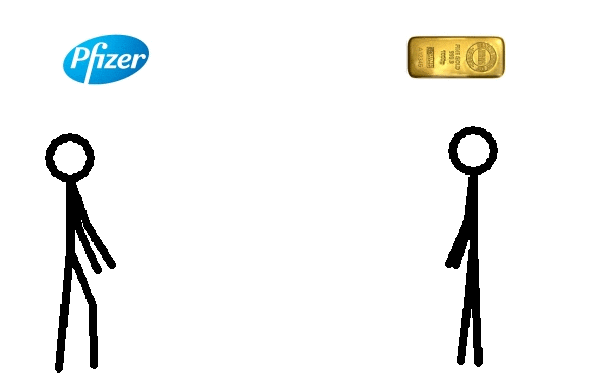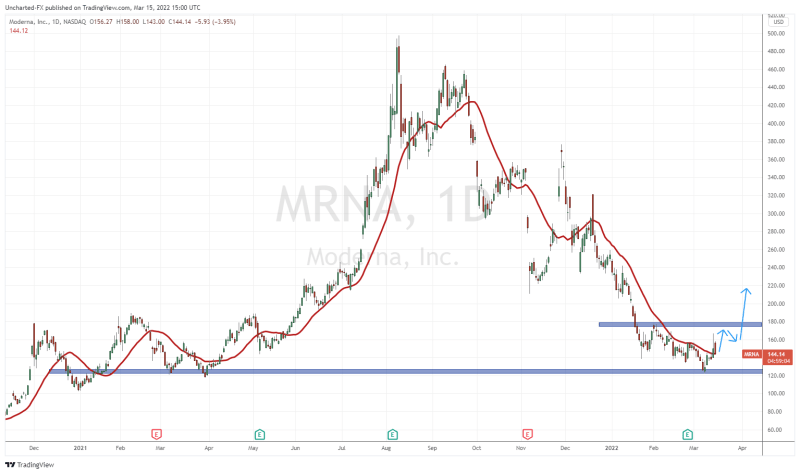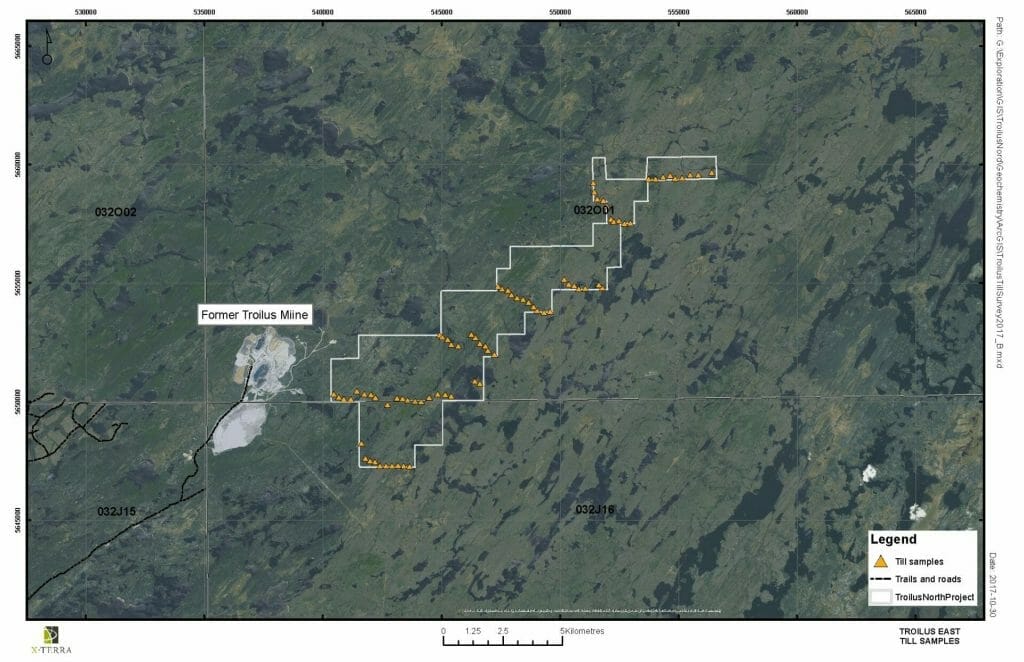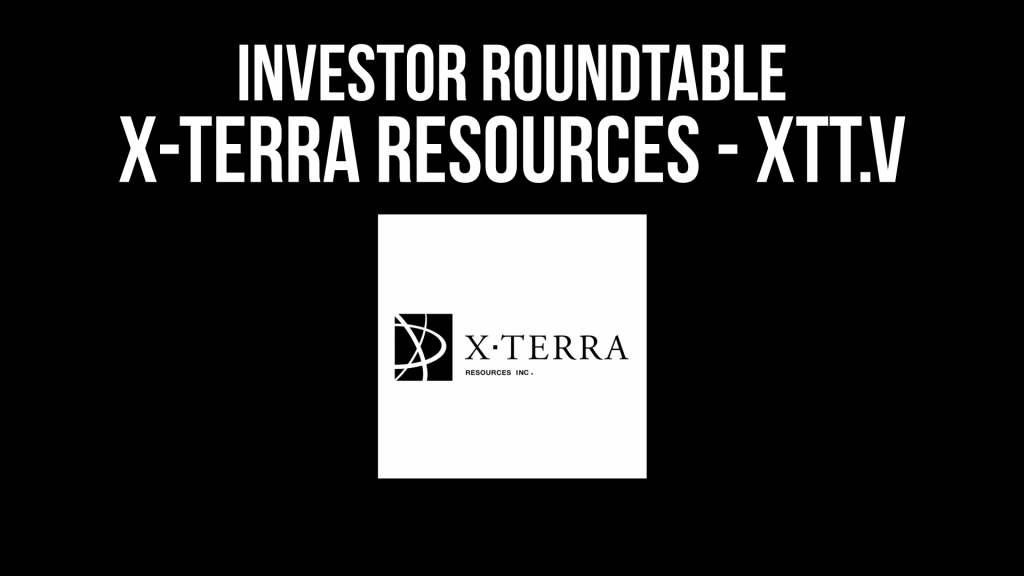On November 9, 2020 the $217 billion drug maker Pfizer (PFE.NYSE) announced that its Covid-19 vaccine candidate was 90% effective in a trial of about 43,000 people.
Bouncing off this good news – the Dow Jones Industrial Average (DJIA) surged 834.57 points (2.95%) to 29,157 and the S&P 500 rose 41.06 points (1.17%) to 3,550.5.
Meanwhile gold got kicked in the gonads.
New York-traded gold for December delivery plummeted $97 (5%) to $1,854. Spot gold, which reflects real-time bullion trades, was down $85.40 (4.4%), to $1,865.81.
“Ole Hansen, head of commodity strategy at Saxo Bank, said that he remains bullish on gold in the near-term as he expects it will take a while before the vaccine is available to the public,” reported Kitco News.
“The virus could go away, but that doesn’t mean economic growth will turn around on a dime,” stated Hansen. “A lot of damage has been done that can ’t easily be fixed or that will take a lot of time.”
Hansen admitted that Pfizer’s news reduced the chances governments will inject more cash into financial markets.
“Basically, we are seeing an unwind of the trade we have been building up for the last six months,” he said. “But there is still plenty of uncertainty to support gold’s new regime. A vaccine is positive news, but it doesn’t change the narrative.” – End of Kitco News.
In fact, 35% of Americans state that they will never take an FDA-approved vaccine because scientists are democrats who use fancy words to trick God-fearing people.
The reality is, the macro-argument in favour of higher gold prices is about debt – not disease.
“We’ve been hearing about the “global debt crisis” for so long it’s become background noise – like a sherry-soaked auntie babbling about UFOs at Thanksgiving,” we wrote one year ago before the pandemic hit our shores, “But if a building has been burning slowly for a long time, it’s legitimate to point out that smoke is still billowing – and there is no fire-truck in sight”.
“According to this week’s New York Federal Reserve Report U.S. household debt increased 0.7% during Q3, 2019, to $14 trillion.
“Consumer debt is now $1.3 trillion higher than the previous peak set in 2008,” stated CNN business, “Household debt has climbed 25% from the post-recession low of $12.7 trillion.”
According to Fed Chairman Jerome H. Powell, there is no reason to panic, although $660 billion of household debt is delinquent, including $424 billion that is “seriously delinquent” (more than 90 days late).
The U.S. government owes about $23 trillion itself (a lot of it to China), and is plunging another $1 trillion in debt every year.”
That’s what we said a year ago, when gold was trading at $1,500 USD.
Our belief in the long-term value of gold – then and now – has nothing to do with this pandemic.
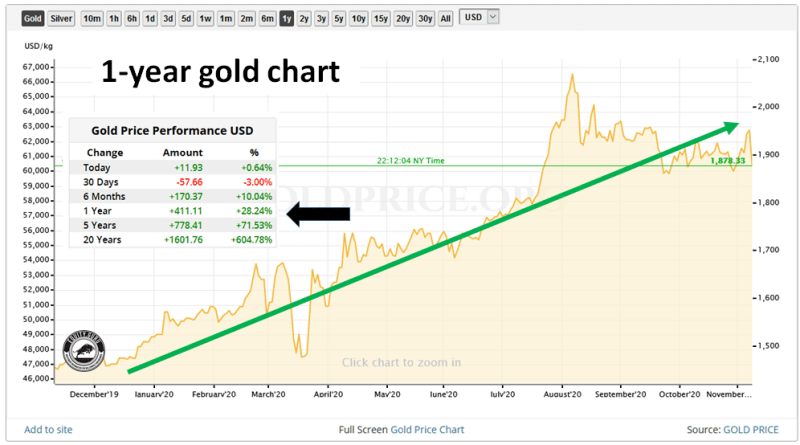
If you’re a momentum trader, selling gold equities into yesterday’s Pfizer vaccine news makes sense.
If you believe in the macro-story of gold-value driven by global debt levels, there is less reason to sell.
I belong to the second category of investors, who anticipate that endless money-printing will devalue fiat (paper) currency.
Typically, if there is a flight to gold, the gold juniors (GDXJ.NYSE) will out-perform bullion and big-cap miners.
Here’s our resident mining expert, Greg Nolan on some of our client gold companies.
From October 16, 2020 p.1 An Equity Guru roundup – the sub-$20M ExplorerCos on our shortlist (1 of 4):
Brigadier Gold (BRG.V)
- 56.3 million shares outstanding
- $16.33M market cap based on its recent $0.29 close
Brigadier Gold (BRG.V) is aggressively working its 3,954-hectare Picachos Gold-Silver Property in the mining-friendly region of Sinaloa, Mexico.
Picachos is flanked on both ends (to the northwest and southeast) by the recent high-grade discoveries of Vizsla Resources (VZLA.V) and GR Silver (GRSL.V).
Note Picachos’ location on the map below (note the scale)…
 Brigadier’s entry into the fray involves more than mere closeology—it’s positioned on-trend, and in a similar geological setting to both discoveries.
Brigadier’s entry into the fray involves more than mere closeology—it’s positioned on-trend, and in a similar geological setting to both discoveries.
This is shaping up to be a productive mineral belt.
Project Highlights:
- Located in the Sierra Madre Occidental Baluarte watershed, between Vizsla Resources‘ Panuco Project and GR Silver’s Plomosas Project;
- A prior operators’ underground channel sampling at the San Agustin Mine returned an average grade of 81.22 g/t gold and 73.36 g/t silver across 1.2 meters;
- Values as high as 185 g/t Au were cut across the bottom of the San Agustin production shaft;
- The San Agustin vein system has never been tested with a diamond drill bit;
- More than 160 known historic underground mines, workings, and prospects at Picachos have gold-rich vein potential;
The company is a good three weeks into a 5,000 meter 40 hole drilling campaign.
Drill targets for this first phase of drilling:
- The San Agustín mine area highlighted above (map below);
- The Mochomos vein where historic rock chip-channel sampling yielded 18.5 g/t Au and 570 g/t Ag across approximately 0.5 meters;
- The Los Tejones vein which yielded values of 28.6 g/t Au and 114 g/t Ag across approximately 1 meter;
- The Fermin vein – values of 268 ppm Ag and 0.3 g/t Au across 1 meter.
On October 6th, the company announced results from a recent sampling campaign along multiple parallel veins which comprise the El Placer vein system.
Highlights:
- El Placer vein system has now been traced for over 4 kilometers;
- Sample assay highlights include:
– 7.4 g/t gold over 3.2 metres;
– 12.8 g/t gold, 54 g/t silver, 0.1% copper, 7.7% lead, and 6.73% zinc over 0.5 metres;
– 101 g/t silver, 0.3% copper, 2% Lead, 11.6% zinc over 1 metre. - Stream sediment samples indicate highly anomalous gold and strong base metals.
Michelle Robinson, Brigadier geologist and rock-kicker extraordinaire:
“The significance of these results cannot be overstated. I have compiled the 1:50 000 SGM data underlying other important gold discoveries in Mexico. For example, the Amalia discovery made by Radius Gold and optioned by Pan-American Silver was indicated by single sample G13C13-101 with an area of 186 hectares and values of 0.06 ppm gold and silver below the detection limit of the analytical method used by the SGM.”
Assay related newsflow should begin over the next few weeks.
Fremont Gold (FRE.V)
- 81.59 million shares outstanding
- $4.9M market cap based on its recent $0.06 close
Fremont is focused on the discovery potential in one of the world’s most prolific and mining-friendly jurisdictions—Nevada.
The company controls four gold projects along the Carlin, Cortez, and Independence Trends.
The Carlin Trend is perhaps the best known of the three having produced tens of millions of Au-ounces since the first discovery in the early 1960s.
Fremont’s Nevada based projects:
The North Carlin project is located on the Carlin Trend. The company is targeting a Carlin-style gold deposit and/or low-sulfidation epithermal mineralization.
The Cobb Creek project is located on the Independence Trend—the target is a Carlin-style gold deposit.
The Griffon project is located on the Cortez Trend—the target is Carlin-style gold.
The Hurricane project is located on the Cortez Trend—the target is a Silica replacement-type gold deposit.
A Carlin-style gold deposit defined.
A recent drilling campaign at the company’s Griffon project failed to meet expectations. The project isn’t dead, but management is boldly shifting focus to the next property along its project pipeline.
The North Carlin Project now bears flagship status.
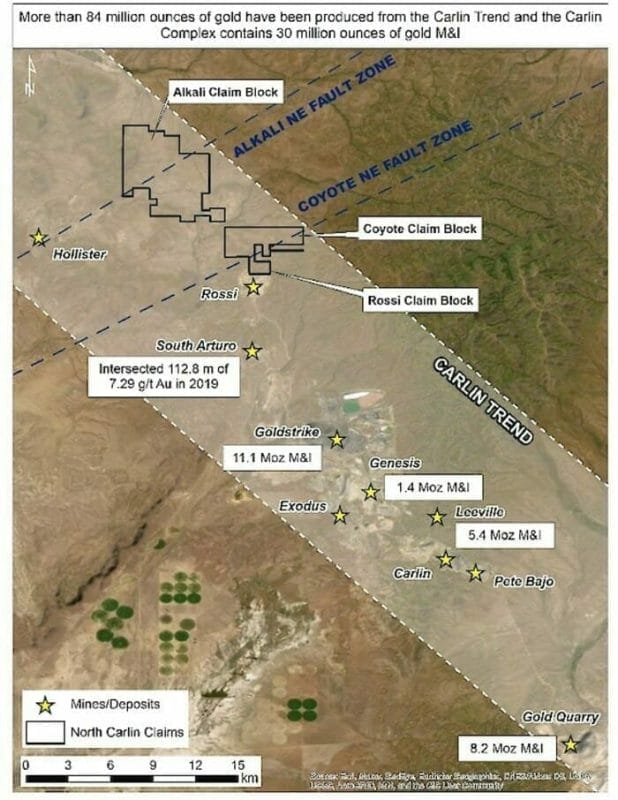
October 7th news: Fremont to Drill North Carlin Project
Highlights from this press release:
- Over 42 square kilometers in size, North Carlin is a large, under-explored chunk of highly prospective terra firma located at the northern end of the Carlin Trend;
- The Carlin Trend is one of the richest gold mining districts in the world having produced over 84 million ounces of gold since the early 1960s – Nevada Gold Mines’ Carlin Complex hosts 30 million ounces of gold in the measured and indicated category;
- The Project is approximately 6 kilometers north of and on-strike of Nevada Gold Mines/Premier Gold Mines’ South Arturo mine where recent drilling intersected 39.6 metres of 17.11 grams per tonne gold;
- The Project is 12 kilometers north of Nevada Gold Mines’ Goldstrike mine which hosts 11.1 million ounces gold in the Measured and Indicated category;
- The western edge of North Carlin is approximately 6 kilometers east of Hecla Minings’ Hollister mine;
- Situated in the right geological setting for a significant discovery, Fremont has developed several high-priority drill targets based on good science—soil geochemistry, gravity and geomagnetic surveys, and the projection of key faults that control gold mineralization along the Carlin Trend;
- The Company is permitting ten drill sites at North Carlin and plans to drill a minimum of 1,500 metres in a reverse circulation program commencing later this fall.
Blaine Monaghan, Fremont CEO:
“We are very excited to start drilling North Carlin. In terms of periodicity and alignment, the Project is strategically located at the northern end of the Carlin Trend. Based on North Carlin’s geological setting and the exploration results to date, we believe that it holds excellent potential for the discovery of a new Carlin-type deposit.”
To kick this drilling campaign into gear, the company just announced a $1M non-brokered private placement.
Fremont to Raise $1.0 Million with a Lead Order from Palisades Goldcorp
There’s more to the Fremont story. We’ll explore North Carlin, Cobb Creek, and various aspects of the company, in greater detail, in the coming days.
From Greg Nolan’s Oct 24, 2020 pt2.An Equity Guru sub-$20M ExplorerCo roundup
Golden Lake Exploration (GLM.C)
- 28.57 million shares outstanding
- $5.71M market cap based on its recent $0.20 close
Golden Lake’s flagship asset is Jewel Ridge, located at the south end of Nevada’s prolific Battle Mountain—Eureka trend. The property lies strategically along strike and contiguous to the Barrick Gold’s (former) two million ounce Archimedes/Ruby Hill mine to the north, and Timberline Resources’ (TBR.V) advanced-stage Lookout Mountain project to the south.
The quarry at Jewel Ridge is a Carlin-style gold deposit…
A Carlin-style gold deposit defined
Nevada’s Carlin-style deposits have a combined mineral endowment of more than 250 million ounces, all concentrated along four main trends: Carlin, Cortez (Battle Mountain-Eureka), Getchell, and Jerritt Canyon.
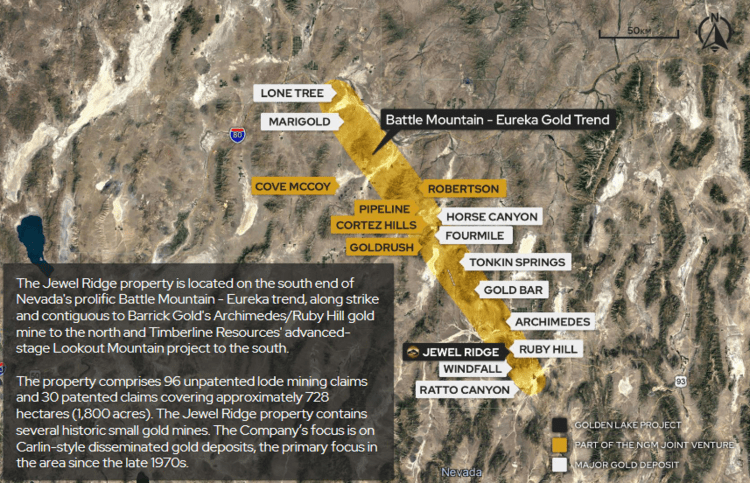 The Company initiated a drilling campaign at Jewel Ridge earlier this summer. We got our first look at the first six holes on September 24th.
The Company initiated a drilling campaign at Jewel Ridge earlier this summer. We got our first look at the first six holes on September 24th.
The headline interval—2.80 g/t Au and 5.9 g/t Ag over 22.86 meters (from surface)—was pulled from the Eureka Tunnel oxide zone. Results reported from the Hamburg zone were a bit of a mixed bag.
Additional assays will flow from Jewel Ridge… eventually—the labs in Nevada are backed up, big time (delays have impacted nearly everyone delivering RC chips and DD core).
On October 20th, the Company announced commencement of a phase two drilling campaign.
“This phase 2 diamond drill program continues on from the summer Phase 1 drilling starting from a prepared drill pad on patented mineral claims located near the Eureka Tunnel adit area. The first angled hole is designed to test for oxide Carlin type oxide near the adit and CRD style replacement west of the adit portal. Additional drilling will focus on the Eureka Tunnel area for approximately a month, followed by drilling in the Hamburg Mine area.”
Mike England, Golden Lake CEO:
“We have switched to diamond drilling for Phase 2 and are aiming to get to depths not accomplished on Phase 1 due to tougher drilling conditions. Results to date have been very encouraging and we look forward to seeing the final 4 hole assays from Phase 1 as we now test deeper and outwards from the initial program coverage.”
The Company has also been active on the acquisition front. The first purchase, announced earlier this summer, was covered by our own Lukas Kane via the following piece:
Read: Golden Lake (GLM.C) buys a new gold project in British Columbia
The Copperview Project is located…
“… on the same regional geologic trend as, and surrounding the “MPD Property” owned by Kodiak Copper (KDK.V). Kodiak recently reported an intercept in drill hole MPD-20-004 of 282 meters averaging 0.70 percent copper and 0.49 grams gold per tonne (see PR Kodiak, September 3, 2020). Kodiak indicates this intercept represents a “significant high-grade copper-gold extension of the recently discovered Gate zone”, located in the well-known, prolific southern portion of the Quesnel trough, host to numerous producing, past-producing and advanced development stage copper-gold porphyry deposits.”
282 meters of .70% Cu and .49 g/t Au is a fat hit. Easy to see why Golden Lake management is attracted to the area.
A reconnaissance exploration program was announced shortly after the acquisition, followed by the announcement that their regional land position grew in size.
Then, on October 22nd, the Company dropped the following headline:
This region in south-central British Columbia will be bustling with activity next field season.
From Greg Nolan’s November 1, 2020 pt.4 An Equity Guru roundup – the sub-$20M ExplorerCos
Sentinel Resources (SNL.C)
- 18.6 million shares outstanding
- $11.53M market cap based on its recent $0.62 close
After announcing the appointment of a seasoned technical team of project hunters to its lineup, Sentinel dropped a number of headlines announcing strategic acquisitions in both Peru and Australia.
Headline #1:
Sentinel Resources Acquires Salama Gold Project, Peru
Consisting of 2,700 hectares of western Peru, the Salama acquisition is highlighted by the following:
- Potential for high and low sulfidation epithermal gold mineralization and breccia pipe stock-work style gold-silver deposits;
- Situated within the prolific gold-polymetallic Miocene skarn and porphyry belt — one of several coast-parallel metallogenic belts that host the larger and more significant deposits of Peru (above map). This includes Lagunas Norte Gold Mine, Rasario De Belen Gold Mine, La Arena Gold Mine, and La Virgen Mine that together host over 20 Moz gold within a 45 kilometer radius of the Salama Concessions;
- A highly experienced national and expatriate exploration team capable of carrying out exploration work on Salama are ready to go;
- A first reconnaissance visit is planned for the week of October 14, 2020. First pass mapping and sampling will concentrate on areas of alteration hosting quartz veins and silicified breccias;
- Previous work by artisanal and small-scale miners provides additional vectors to areas of higher-grade mineralization.
The next headline, on October 6th, drew the curtain on a weighty acquisition in the New South Wales region of Australia, an acquisition that immediately took on flagship status:
SENTINEL ACQUIRES EIGHT GOLD EXPLORATION CONCESSIONS IN NEW SOUTH WALES, AUSTRALIA
Acquisition highlights:
- At least 198 historic gold mines and gold exploration prospects are present across 8 separate projects;
- Historic production records indicate that gold grades were often multi-ounce (see News South Wales Department of Planning, Industry and Environment);
- The licences are strategically located within the prolifically mineralized Lachlan and New England orogenic terranes;
- Sentinel applied to the Manager of Minerals Titles, New South Wales Department of Mining, Exploration and Geosciences for the concessions. The concessions will be 100% owned with no royalties or back-in rights, upon completion of the acquisition process.
- Sentinel has engaged a highly experienced exploration team to commence a reconnaissance work program on high-grade historic mines and showings this November 2020. The focus is to identify high-grade drill ready targets.
The vast majority of Sentinel’s resources (and exploration spending) will be focused on this newly acquired Australian project portfolio.
This is not an early-stage undertaking. These projects have been de-risked to a large degree owing to the past-producing mines and high-grade showings in the region.
Continuing on the hunt for strategic precious metals project’s in the Land Down Under, Sentinel unveiled another weighty acquisition on October 13th:
SENTINEL ACQUIRES SEVEN SILVER EXPLORATION CONCESSIONS IN NEW SOUTH WALES, AUSTRALIA
Acquisition highlights:
- At least 23 historic silver and 3 historic gold mines and exploration prospects are present across the project areas;
- Historic production records indicate that silver grades were generally high-grade, and in some instances, exceeded 1 kg/t Ag (see News South Wales Department of Planning, Industry and Environment);
- Six of the licences are strategically located within the well-mineralized Lachlan orogenic terrane. One licence is located in the world-class Broken Hill region of the Curnamona Province;
- Sentinel applied to the Manager of Minerals Titles, New South Wales Department of Mining, Exploration, and Geosciences for the concessions;
- The concessions will be 100% owned with no royalties or back-in rights upon completion of acquisition process. Sentinel will be required to post a refundable performance bond of AU$10,000 per concession and spend exploration and associated expenses on each concession of AU$ 25,000 in Year One and AU$50,000 in Year Two;
- Sentinel’s technical team is currently reviewing historic data in order to fast track reconnaissance follow-up and definition of high-grade drill ready targets.
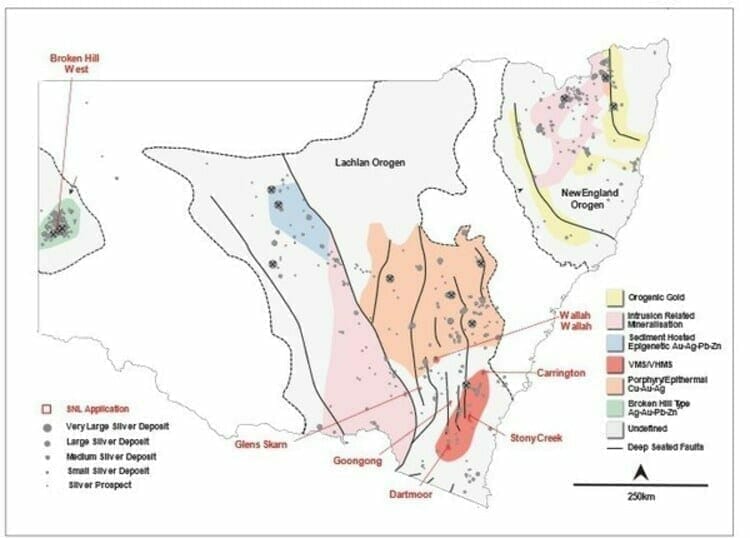 Figure 1: Sentinel’s 7 Silver Projects located in New South Wales, Australia (CNW Group/Sentinel Resources Corp.)
Figure 1: Sentinel’s 7 Silver Projects located in New South Wales, Australia (CNW Group/Sentinel Resources Corp.)
The Company’s exploration team—Dr. Peter Pollard (Chief Geologist of Sentinel), and Dr. Christopher Wilson (Senior Advisor)—was quick to provide a initial review of its recently acquired (gold) ground in New South Wales.
A first pass review of available historic data indicates that both Alliance Reef and Wittagoona Reef on the Peel-Manning fault system, and Toolom South in the Mount Carrington gold camp, host a number of high-quality targets.
Highlights from this first pass review:
Alliance Reef (ELA 6057)
- Located on the 350 kilometer long Peel-Manning Fault — a crustal-scale fault zone that hosts variably quartz-carbonate altered serpentinites (otherwise known as listwanites);
- A 102 km2 licence hosting 28 historic gold mines with reported production grades of up to 15 g/t Au.
Along strike, and immediately adjacent to the historic Nundle alluvial gold field that produced more than 225,000 ounces of gold; - Includes the historic Marquis of Lorne gold mine with a cited historic resource estimate of 336,000 tonnes at 4.75 g/t Au for 51,000 ounces of gold. The historical resource estimate was set out in a report on the Marquis of Lorne Nundle Project prepared in November 1990. The historical resource estimate does not use the categories, such as mineral reserves or mineral resources, set forth in CIM. Although the Company is currently reviewing the reliability of the resource estimate, the Company believes it is relevant as it represents a key exploration target at Alliance Reefs. To upgrade the historical resource estimate, the Company will be required to carry out drilling on the Marquis of Lorne gold mine. The qualified person has not done sufficient work to classify the historical estimate as a current mineral resource or mineral reserves. The Company is not treating the historical estimate as current mineral resources or mineral reserves;
- Analogous deposits include the Californian Motherlode, Bralorne in British Columbia, and large high-grade gold deposits in the shield area of Saudi Arabia;
- Unlike quartz-dominant orogenic deposits (such as the Abitibi, those in West Africa and Western Australia) which are characterized by obvious quartz vein targets, listwanite-hosted systems are often subtle and under-explored;
- The Peel-Manning system is noted for extensive, historic alluvial deposits, indicating that the listwanites are mineralized with gold.
Toolom South (ELA 6061)
- Located within the historic Toolom alluvial goldfield with reported production of more than 1 million ounces of gold;
- Over 60 historic gold mines — some with reported multi-ounce grades;
- The Phoenix deposit is situated approximately 5 kilometes NW of the concession, classified as an intrusion related gold rich breccia pipe (highlight intercepts from initial drilling include 48 meters @ 2.21 g/t Au).
Golden Bar (ELA 6061)
- A 198 km2 licence with at least 50 historic gold mines and showings, most likely of a low-sulphidation type;
- Historic mines and showings define two structural corridors with a cumulative strike length of over 20 kilometers. Historic production grades routinely rang in above 50 g/t Au.
Stanleys (ELA 6062)
- A 90 km2 licence located within a prolific gold camp comprising deposits such as Commonwealth, Copper Hill (1 Moz Au), Hill End (0.7 Moz Au), Cadia (43 Moz Au), and McPillamys (2 Moz Au). Readers should note that mineralization contained on these projects is not necessarily indicative of mineralization contained at Stanleys;
- At least 17 historic small-scale gold mines and prospects with cited historic production grades of up to 185 g/t Au.
Alliance Reef, with its historic resource of 336,000 tonnes at 4.75 g/t Au, represents an interesting target for follow-up exploration—exploration of the ‘resource-expansion’ kind.
Having recently cashed-up to the tune of $1M, the Company is planning an aggressive field campaign initially focused on the projects highlighted above.
Field work will consist of reconnaissance mapping and geochemical sampling in order to ground-truth the tenor and styles of the mineralization present.
According to this press release, a review of regional geophysical and topographic data is ongoing. This data, along with results from this first pass field mapping, will assist in generating high-priority drill targets across the region.
“Review of the remaining gold licences — Wittagoona Reef, Star of Hope, Lady Mary and Waddaderry West — is ongoing. Sentinel will announce results of this study shortly.”
The news continues to flow out of Sentinel (this crew refuses to come up for air).
On October 26th, the Company updated progress with its Ag assets:
Here, Dr. Peter Pollard (Chief Geologist of Sentinel), and Dr. Christopher Wilson (Senior Advisor) provided an initial review of the silver concessions recently acquired in New South Wales. The exploration licenses are known as Wallah Wallah, Stony Creek, Carrington, Dartmoor, Glens Skarns, Broken Hill West, and Goongong.
Highlights from this first pass review:
Wallah Wallah (ELA 6065)
- A 99 km2 licence hosting 6 historic silver mines and showings with reported rock-chip grading over 1,000 g/t Ag;
- The historic Wallah Wallah prospect comprises mineralized lodes which crop out as gossans over a strike length of 2 kilometers;
- Historic records indicate that one lode was exploited to a depth of at least 46 meters on four levels. Records indicate several thousand tonnes of material was processed at grades of 950 g/t Ag and 30% Pb;
- The system is relatively unexplored, but the presence of minor tin, topaz, and tourmaline with the silver-lead mineralization suggests it forms part of an intrusion-related system possibly related to nearby Devonian granites.
Stoney Creek (ELA 6082)
- An 81 km2 licence hosting 7 high-grade, historic silver and gold mines and showings;
- Mineralization is likely of a low-sulphidation epithermal type — characterized by vein-hosted high-grade shoots;
- The Stoney Creek prospect comprises quartz-sulphide veins within an 85 meter wide zone of alteration. Historic rock-chip grab samples assayed up to 18 g/t Au and 212 g/t Ag;
- Gundillions Reef is defined by a series of shafts, drives and small open pits that have been worked to a depth of approximately 200 meters. Rock-chip grab samples returned assays of up to 50 g/t Au.
Carrington (ELA 6080)
- Carrington contains a number of historic mines and workings within gold-silver mineralized gossanous lodes (gossans form when sulphide mineralization is exposed to surface and “rusts” to an iron oxide residue). Gossans are important vectors to underlying sulphide mineralization;
- Three historic silver-gold mines targeted silver-gold mineralized gossans. Historic rock chip grab samples of this material assayed up to 85 g/t Au, 6037 g/t Ag, 24.85 Pb and 16.75% Sb (antimony);
- Significantly, the NSW government “minview” website states that over 0.5 Mt of iron gossan is present. This is significant given silver-gold mineralization is associated with gossans developed above primary sulphide mineralization. The tonnage cited suggests a robust system.
Additional Silver Projects (ELA 6080)
- Sentinel’s review of Broken Hill West (EAL 6078), Glens Skarns (ELA 6066), Goongong (ELA 6091) and Dartmoor (ELA 6084) is ongoing:
- Broken Hill West is located 2.5 kilometers to the west of the Broken Hill mine complex and shares similar geology and structure. There has been minimal exploration due to an extensive cover of recent alluvium;
- Glens Skarns has four mineralized skarns over a strike length of 7.5 kilometers. The Sentinel team believes these are four priority targets;
- Historic rock chip sampling at Glens Skarns returned results of up to 80 g/t Ag, 5% Cu, 0.28% Pb, 1.26 % Zn, 100 g/t Sn and 1700 g/t W (tungsten);
- Dartmoor hosts Kuroko-style VMS mineralization which can be traced as gossanous outcrops over a strike length of 1.5 kilometers. Small scale historic production records cite silver grades of up to 900 g/t;
- Goongong hosts four historic silver mines and prospects of polymetallic skarn style with anomalous silver, copper, lead, zinc, tin and tungsten.
This press release states that in addition to high-grade silver referenced, Stoney Creek and Carrington also report high-grade gold assays.
Assessing this large historic dataset must be a daunting task. Without a doubt, reviewing and modeling this historic data, in order to prioritize these highly prospective assets, will be an ongoing process. But this is a good problem to have (I’m sure there have been a number of ‘eureka’ type moments at the Co headquarters).
On October 29th, the Company dropped the following headline:
Another key hire for the Company.
“Mr. Rampe (B.Sc (App. Geol.), MAusIMM (CP), MICA, MAIG) is an experienced exploration geologist with 45 years of mineral exploration and project development from grass roots exploration through to pre-mine development.”
Boasting a n array of skillsets, Rampe will oversee regulatory filings, land-holder access, and provide additional geological support as required.
A company like Sentinel, with its fat stack of highly prospective assets, can never have too many geos in its lineup.
Tocvan Ventures (TOC.C)
- 24.45 million shares outstanding
- $9.29M market cap based on its recent $0.38 close
Tocvan’s flagship Pilar Gold Project is located along the historic Sonora gold district within the Sierra Madre Occidental geological province. The project is road accessible and is located roughly 140 kilometers south-east of the city of Hermosillo.
Sonora, a mining-friendly jurisdiction steeped in the culture, is currently credited for nearly 37% of Mexico’s annual gold production (the country’s largest Au contributor).
Pilar has been identified as a structurally controlled low sulfidation epithermal gold-silver setting.
“Hydrothermal fluids carrying gold, silver and other minerals are transported through the pre-existing structures and deposit out of the fluids and become emplaced within the structures and surrounding host rock. Alteration minerals help to identify the location and direction of the structural features containing the gold and silver.”
An advanced stage exploration asset, Pilar has seen multiple phases of work over the past few decades, including extensive trenching, soil sampling, geophysics, and > 17,000 meters of drilling.
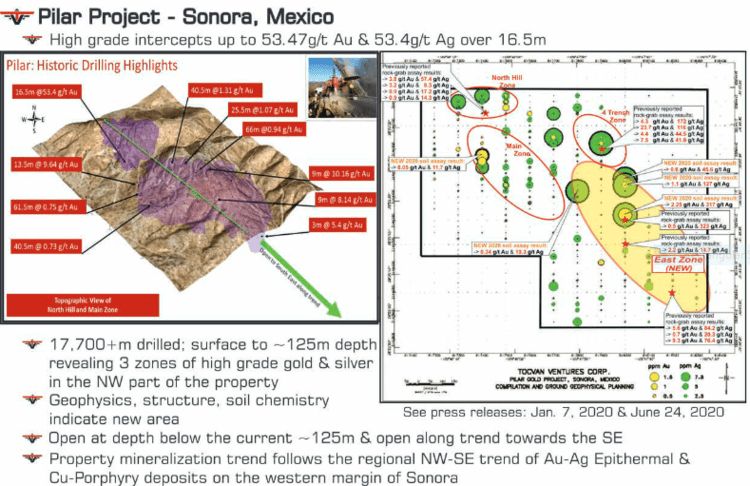 Highlights from these previous drilling campaigns include:
Highlights from these previous drilling campaigns include:
- 0.73g/t Au over 40 meters
- 0.75g/t Au over 61 meters
- 17.3g/t Au over 1.5 meters
- 5.27g/t Au over 3 meters
- 53.47g/t Au & 53.4g/t Ag over 16 meters (BOOM, mic drop y’all)
- 9.64g/t Au over 13 meters
- 10.6g/t Au & 37.8g/t Ag over 9 meters
Highlights from 2,650 meters of surface and trench/channel sampling include:
- 55g/t Au over 3 meters
- 28.6g/t Au over 6 meters
- 3.39 g/t Au over 50 meters
Tocvan management sees multi-million-ounce potential in this asset.
In a June 24th press release, the Company tabled assays representing the highest soil values encountered on the property to date—8 g/t Au & 317 g/t Ag.
A new zone of high grade Au and Ag mineralization—the East Zone—was also unveiled in this press release.
In a press release dated September 28th, the Company reported a sub-vertical 100-meter wide pipe-like feature in the east-central part of the property, a feature that may represent a breccia feeder pipe related to epithermal mineralization.
The pipe is ~100 meters in diameter, oval shaped, steeply plunging, and appears to be controlled by a fold nose based on interpreted basement folding.
These pipe-structures often form in areas of weakness—at the intersection of faults, for example—and have the potential to host high-grade mineralization.

In an October 14th press release—Tocvan Announces the Association of the High-Grade Silver East Zone With a Pipe-Like Feature, at the Pilar Gold-Silver Project in Sonora, Mexico—a second circular pipe-like feature was identified via geochemistry.
Both of these anomalies follow the main northwest to southeast shear structure that runs through the property.
On October 26th, as it inches closer to mobilizing a drill rig to Pilar, the Company dropped the following headline:
Tocvan Announces Drill Targets, at the Pilar Gold-Silver Project in Sonora, Mexico
Successes have been achieved from the Phase 1 target generating program over the past six months to locate targets for drill testing. MPH Consulting Limited, and SRK Consulting (Canada) Inc. have completed the structural analyses on the Pilar Property in Mexico. High grade gold and silver are located within and controlled by structures such as faults, intersecting faults, and dilated structures.
Results from the study show deep penetrating sub-vertical north-trending structures found within the northwest trending structural shear corridor. Gold and silver mineralization correspond with north-trending structures and are bounded within the northwest trending shear zone. The north-trending faults are extensional features that can be interpreted as en-echelon (dilational) structures. These dilational faults have an approximate length of 300m, extend from surface to an approximate depth of 600m, and are repeating structures within the northwest trending large shear corridor across the property for at least 1,000m. Additional drill targets, where gold values are also controlled, are at the intersections of north-trending faults with northwest-trending shear structures. These intersections are often areas of weaknesses, dilated, and present as pockets and chutes.
Regarding timelines… “Drill permitting is underway and is pending.”
X-Terra (XTT.V)
- 71.39 million shares outstanding
- $10.71M market cap based on its recent $0.15 close
The company’s 280 square kilometer Grog and Northwest projects are located along the McKenzie Gulch Fault in Northeastern New Brunswick.
The target at Grog is a large intrusion-related epithermal system.
An 11-hole drill program conducted earlier this year yielded a new discovery in hole GRG-20-012: 0.41 g/t Au over 36 meters (including 0.46 g/t Au over 31 meters and 7.59 g/t Au over 0.6 meters) at a vertical depth of 81 meters.
On September 21st, the Company established a good correlation between geophysics and geochemistry at Grog.
A total of 128 geochemical samples were collected over 3 parallel lines (with approx 150 meters between lines)—the samples were taken every 25 meters. The objective was not only to confirm the position of the gold-bearing structure at Grog, but to test and confirm the possibility of parallel signatures identified via 3-D magnetic inversion analysis.
The B Horizon samples allowed X-Terra to determine rock types, alteration patterns, and precise levels of pathfinder elements such as Arsenic (As) and Antimony (Sb). The results yielded values up to 36 ppb Au, 291 ppm As, and 25.8 ppm Sb.
Elevated gold anomalies were identified on two of the three lines centered on the Grog target.
The arsenic and antimony elements complement the signature, offering a better read on the identified Grog target (antimony and arsenic are two key pathfinders for gold).
The combined, superimposed Au-As-Sb anomaly now outlines this target to 250 metres in width while also extending it approximately 750 metres. Excitingly enough, the same type of anomaly was able to be identified 700 metres east-south-east of the Grog target on a parallel trend.
Michael Ferreira, X-Terra CEO:
“The correlation obtained during this phase of works between low mag, high resistivity and gold-arsenic-anomaly at the margin can be considered a significant step up in our understanding of the Grog system. Not only was the kilometric strike length of the known gold system reached and confirmed by a common signature, but our hypothesis was validated that two other parallel trends of the same orientation and thickness creating a 5km2 target. This threshold was an important step to reach considering that, this scale is widely accepted as precedent for exploring a deposit of a significant size.”
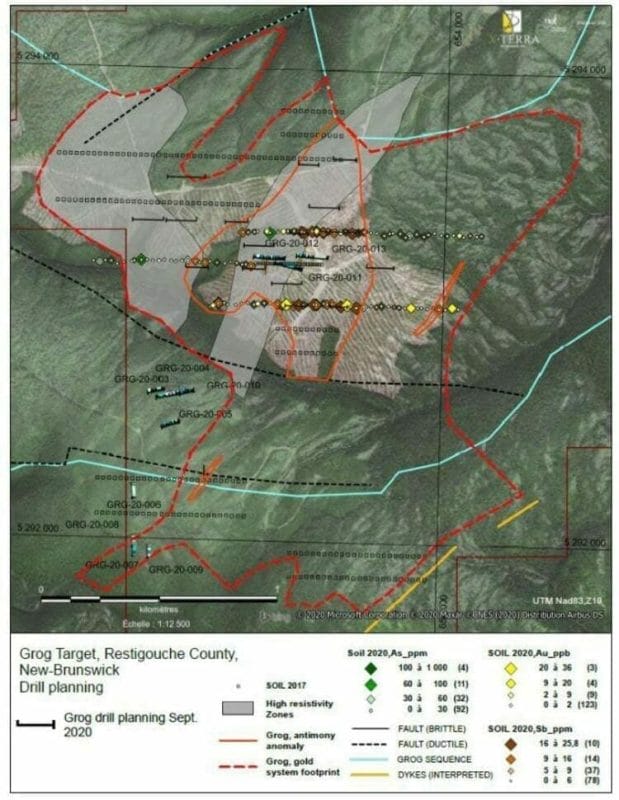 Highlights from this Sep. 21st press release:
Highlights from this Sep. 21st press release:
- X-Terra has increased the size of the original drill program (11 holes) to a total of 20 holes which include 4 shallow holes (100 meters) at the Rim target, and 16 holes (150 to 300 meters) at the Grog target;
- Gold-in-soil anomalies above the Rim vein in addition to 4 other gold occurrences highlight the stacking possibility of additional gold bearing veins.
On October 13th, X-Terra dropped the following headline:
Here, the Company announced that drilling had commenced at Rim and Grog with two rigs.
Recent ground (IP) geophysics and geochemical sampling contributed to the final planning of this drilling campaign in a big way.
The drill section planned over the Rim vein target covers approximately 500 metres following a west north-west orientation cross cutting the main structural orientation. Gold bearing veins are believed to be concordant or parallel to the sedimentary bedding.
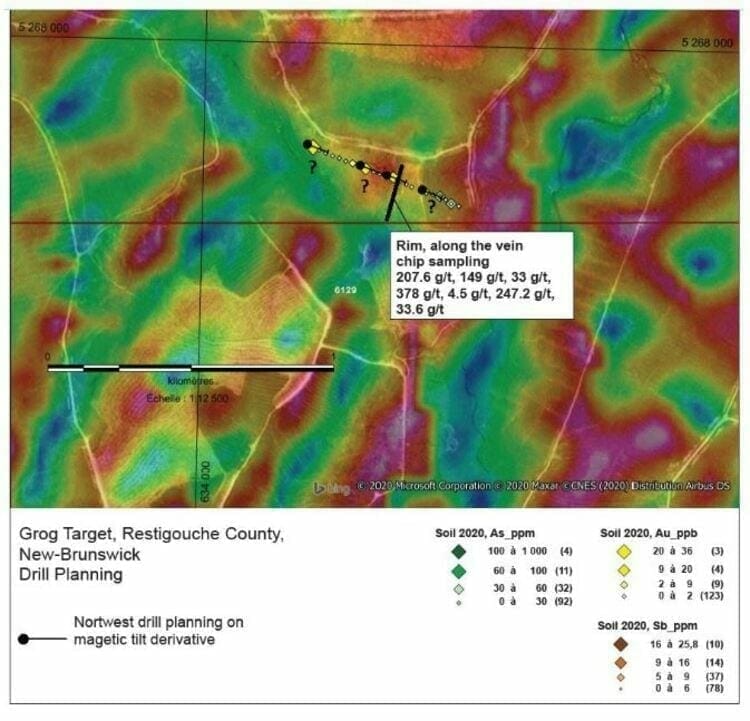 CEO Ferreira again:
CEO Ferreira again:
“X-Terra’s exploration team and drilling crews are excited to be drilling the Rim vein target which has never been drill tested, and given the additional gold-in-soil anomalies, it highlights the compelling possibility of a stacking of gold bearing veins below. The Rim vein target has yielded incredible gold grades from 4.5 g/t Au to 1,205 g/t Au with visible gold –(See X-Terra’s press release dated December 5, 2018). Its fantastic that we were able to secure a second drill to begin drilling the Grog target at the same time,as this should reduce the wait time for the first batch of results. Furthermore, this will be X-Terra’s largest drill program completed on any of its properties to date”.
During a recent chat with CEO Ferreira, I learned that drilling at Grog and Rim progressed without a hitch. Having worked as a contractor on highly technical, logistically challenging projects in the resource sector myself, I was impressed with the efficiencies Ferreira was able to deploy during this campaign.
I also learned that at least one hole at Grog tagged multiple zones of mineralization. Of course, hitting the right rock doesn’t necessarily guarantee economic values.
X-Terra is also working its wholly-owned 93 square kilometer Troilus East property along the Frotet-Evans Greenstone Belt in northern Québec.
Troilus East shares a common border with Troilus Gold (TLG.T).
Troilus Gold boasts a current resource of 4.96 Moz AuEq Indicated (177 Mt with an average grade of 0.87 g/t AuEq) and 3.15 Moz AuEq Inferred (116.7 Mt with an average grade of 0.84 g/t AuEq).
This is a vastly under-explored region with latent world-class potential.
On October 15th, the Company announced the launch a MMI, humus, and till sampling campaign at Troilus East.
The program will cover (5) unique grids, including the new mineralized system discovered this past summer, (See X-Terra press release dated August 13, 2020), with the goal of identifying drill targets for a program to be launched later this year.
The highest priority target is located about three kilometres east of the Troilus deposit (Troilus Gold, TSX: TLG) following the southwestern side of the property. The 2.2-kilometre-long target is based on the discovery by surface exploration of a polymetallic signature (Cu, Ag, Au, W). The mixed sequence of intermediate volcanic interlayered with dioritic intrusions identified in this area shares many similarities with the Troilus deposit.
The four other sampling grids are distributed over a north-east structural corridor covering a strike length of approximately 13 kilometres. Targets were identified through a previous till survey using recovered gold grains. Despite the historical two kilometres spacing between lines, the systematic location of gold grain counts adjacent to strong magnetic contrasts can be considered as an indicator of a gold bearing structure.
If things play out according to plan, we’ll see a drill rig mobilized to Troilus East later this quarter.”
- End of Greg Nolan
There have been over 50 million reported cases of COVID-19 resulting in 1,260,768 deaths worldwide.
“Today is a great day for science and humanity,” stated Dr. Albert Bourla, Chairman CEO of Pfizer, “The first set of results from our Phase 3 Covid-19 vaccine trial provides the initial evidence of our vaccine’s ability to prevent Covid-19.”
Pfizer stated that it can produce 50 million doses of its vaccine in 2020 and up to 1.3 billion in 2021.
By midnight Vancouver time, Dow Futures has dropped 125 points while gold was up $27.
- Lukas Kane
Full Disclosure: BRG.V, FRE.V, GLM.C, SNL.C, TOC.C, XTT.V are Equity Guru marketing clients.

